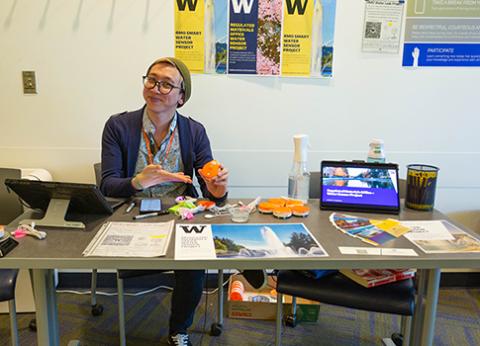Link to UW

Eric Barton is separated from the nearest Link light rail station by some 15 miles of distance, plus one sizable body of water.
But even so, the extension of light rail to the University of Washington campus transformed his UW commute for the better. His story goes to show that light rail could help you discover a much-improved commute, even if you don’t live right next to a station.
“It’s much faster,” Barton says of his new commute featuring light rail. “It’s less frustrating.”
Barton, a medical resident at UW Medical Center and a graduate student in the School of Public Health, lives in Kingston, on the west side of Puget Sound in Kitsap County. A lieutenant commander in the Navy, he worked at Naval Base Kitsap-Bangor for five years before beginning his residency at the UW, and he might be assigned there again after finishing his residency. He opted to keep living near the base in Kingston, rather than moving his wife and two young children from their house for a two-year residency in Seattle.
Though it meant his family wouldn’t have to pack up and move, the decision to stay put did mean a lengthy commute for Barton, who during the school year spends four days per week on the UW campus and one day at Harborview Medical Center. He opted to take transit to Seattle so that he could spend his commute reading for class.
“It was a pretty long and tiring commute every day,” he says. It took roughly three hours each way.
He would drive to a park-and-ride in Kingston; take a bus from there to the Bainbridge Island ferry terminal; take the ferry to Seattle; walk from the terminal there to Pioneer Square; then take an express bus to campus from there.
But when UW Station opened in March, things got much better. Instead of riding a bus to campus through jammed traffic, he could zip underground on light rail and emerge across the street from UWMC. He says it cut about an hour off his commute time, on average, and made things much more predictable. Free from traffic, light rail provides reliable service, allowing Barton to plan his days more easily.
“The light rail seems to come by at the perfect time every time I get there,” he says.
Barton says transit is clearly the best choice for his commute, even though he lives a good distance from campus. Driving to campus would still take up a lot of his time, and it would cost much more money. He can use his time riding transit to study, and spend time with his family when he gets home.
“I get the evening to spend with them, rather than catch up on all the articles I have to read that day,” he says.
And with the U-PASS program, and the Navy Transportation Incentive Program that helps cover his ferry fare, his transit commute is affordable.
“Get the U-PASS,” Barton advises. “It makes everything very easy and affordable.”
With U-PASS and Link light rail – including the new park-and-ride Angle Lake Station, opening this year – a transit commute might be a good choice for you, too, even if you live a good distance from campus.
Need help figuring out a transit commute? Contact our Commute Options staff for a customized commute plan.




